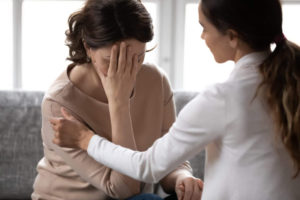What is depression?
Depression is a mood disorder that causes an individual to experience persistent feelings of depressed mood or sadness and a general disinterest in things that normally make them happy or feel satisfied. According to the National Institute of Mental Health, more than 17 million Americans have had at least one major depressive episode in their lifetimes, which is roughly 7% of all U.S. adults.
Depression can interfere with your ability to do normal, everyday tasks since it affects how you feel, think and act. A depressive episode typically lasts between a few weeks and several months, but a depressive episode may last longer than a year.
What are the types of depression?
There are a few common types of depression, major depressive disorder (MDD), persistent depressive disorder (dysthymia), bipolar disorder, postpartum depression (PPD), and seasonal affective disorder. Understanding the different depression symptoms between each type is critical to getting an accurate diagnosis and treatment.
1. Major Depressive Disorder
Also known as clinical depression, this is the classic type of depression we are accustomed to hearing about. Symptoms of MDD include a persistent feeling of sadness, loss of interest in activities you once enjoyed, difficulty sleeping, change in appetite or weight, lack of energy, or feeling worthless. Suicidal or morbid thoughts may also be experienced. For this type of depression, therapy or antidepressant medications may be effective.
2. Persistent Depressive Disorder
Also referred to as PDD and formerly referred to as “dysthymia,” this type of depression lasts for several years (normally at least two years) but is often less severe than major depression. However, those who suffer from PDD can also experience a major depressive episode. People with persistent depressive disorder can do everyday tasks but usually have low energy or feel joyless most of the time.
3. Bipolar Disorder
This mental health condition, sometimes referred to as manic depression, is characterized by extreme changes in mood, energy, behavior, sleep patterns, and thoughts. These frequent mood swings not only make you feel depressed but may lead to suicidal thoughts that rapidly change to feelings of joy and euphoria. It’s important to note that bipolar disorder can include the same symptoms as depression, but there are differences between depression and bipolar disorder.
4. Postpartum Depression
Postpartum depression (PPD) affects new mothers and is a result of the hormonal changes that stem from childbirth. It is not uncommon for new mothers to experience the “baby blues” but these symptoms are typically mild when compared to postpartum depression. In more severe cases, the crying, sadness, and depression symptoms can last for up to a year and can have devastating affects on the new mother, the baby, and the family.
5. Seasonal Affective Disorder
As the name implies, this type of depression occurs when the seasons change. Most commonly, this happens when we transition into fall or winter, but it can also happen during the spring or summer. As the days get shorter and lose daylight, this can disrupt our body clock, lower serotonin levels, or increase melatonin levels, leading to changes in mood or behavior.
National Depression Screening Day
Thursday, October 8th, 2020 is National Depression Screening Day. An effective way to treat or mitigate any health condition, in this case a mental health condition, is to conduct a screening appointment with a medical professional. If you have any negative thoughts or symptoms of depression, call Boston Clinical Trials at 617-477-4868 for a confidential consultation with a member of our psychiatric team.








